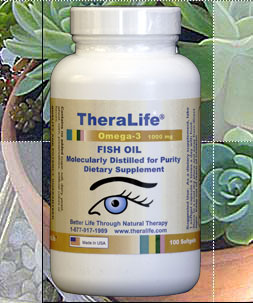
Omega 3 Fish Oil is often recommended for dry eye relief.
Read on. See if your diet patterns lead to a healthier you.
Omega 3 Fish Oil has strong anti-inflammatory properties that fights inflammation in people with dry eyes. In addition, it also thickens the tear in cases where tear viscosity is too low, resulting in evaporative dry eyes.
One of the main reasons why Omega 3 Fatty Acids alone is not enough is because inflammation from dry eyes resulted in under-active tear secretion glands. Only TheraLife Eye can restore and activate tear secretion glands and make them secrete balanced tears again.
People with chronic dry eye syndrome suffer from discomfort such as dry, painful, sandy gritty, tired, stinging symptoms with eyes that maybe very light sensitive. These symptoms can be . stubbornly persistent even with conventional dry eye remedies such as eye drops, punctal plugs, and more. The more one uses eye drops, the drier the eyes becomes. Drops wash away the natural lubricants the eye produces.
There is a great amount of interest in the use of essential fatty acids (EFAs) as an adjunct in the treatment of chronic dry eye symptom. In heart diseases, Essential Fatty Acids, such as those in TheraLife Omega 3 Fish Oil have been shown to play a role in inflammatory processes leading to improved changes to the heart. The cause of dry eye is often inflammatory in nature, therefore, the anti-inflammatory actions of Omega 3 Fish Oil can really help people with chronic dry eye syndrome.
Foods and supplements containing Omega 3 are used to relief dry eye syndrome. In North America, the diets are known to be very low in omega-3 essential fatty acids. Omega 3 Fatty Acids are believed to be beneficial for maintaining normal tear production.
The two best sources of omega-3s are:
- dark, oily, cold-water fish
- flaxseed.
What is the difference between Omega 3 and Omega 6 Fatty Acids?
Omega-6s (the bad fatty acid) can promote dry eye syndrome. Omega 3 fatty acids can help relief dry eye syndrome.
Too much Omega 6, not enough Omega 3
People living in developed countries, especially Americans obtain an excess of omega-6s through their consumption of beef, dairy, vegetable shortening and cooking oils (i.e. hamburgers, cheeseburgers, pizza, ice cream, potato chips, etc.). It is thought that intake ratio of omega-3 to omega-6 fatty acids ideally should be at least 1:4 and preferably 1:2.3. However, the ratio is typically much lower in a diet typical of developed countries which tends to be high in meat and processed food. In one study, a high intake ratio of omega-3 to omega-6 fatty acids resulted in a decreased likelihood of suffering from dry eye syndrome, while women with lower than a 1:15 omega-3/omega-6 fatty acids ratio had a 2.5 times greater prevalence of dry eye syndrome. If too much omega-6 fatty acid is ingested due to a diet high in processed meats and low in unprocessed oils and omega-3 fatty acids, then increased levels of pro-inflammatory prostaglandin E2 (PGE2), and low levels of anti-inflammatory agents PGE1 and PGE3, may lead to dry eye. The effectiveness of essential fatty acids as a treatment for dry eye syndrome is dependent on the proper balance of omega-6 and omega-3 fatty acids.
Omega 3 fatty acid help reduce Meibomian Gland Dysfunction (MGD).
The effectiveness of fatty acid treatment of dry eye syndrome is also dependent on specific nutrient co-factors that help the metabolic conversion to anti-inflammatory prostaglandins. These nutrient co-factors stimulate the production of healthy goblet cells and enhance production of clearer and thinner meibomian gland secretion. Omega-3 fatty acids also play an important role in the synthesis of meibum, the oil secreted by meibomian glands. People with omega-3 fatty acid deficiency typically have a thicker meibomian gland secretion. The use of omega-3 fatty acid supplements results in clearing and thinning of meibomian gland secretions which in turn improves symptoms of dry eye. Properly designed formulations also encourage lacrimal gland secretion and the production of tear lactoferrin.
TheraLife® Omega-3 Fish Oil- Molecularly Distilled
TheraLife®Dry Eye Enhanced and TheraLife® Omega-3 Fish Oil taken together provides added benefits- Reduce chronic inflammation from dry eye conditions.
- Produces a better quality tear that prevents excessive tear evaporation.
- Reduce risk of Macular Degeneration, Cataract and other various age related eye disorders.
- Omega-3's benefit other regions of the body including the brain, immune system, cardiovascular system and the skin.
TheraLife® Omega-3 Fish Oil is molecularly distilled to reduce levels of mercury and other contaminants. We provide the highest levels of
- Quality
- Purity
- Potency
Learn More
Video
Visit Our Store.
Scroll Down To See All The Selections.

Call and talk to a Doctor toll free 1-877-917-1989 US & Canada
International (650) 949-6080
Follow us on twitter and facebook.


Omega 3 Fatty Acids from Fish Oil is a vital component in dry eye relief. But Fish Oil or Flaxseed Oil alone is not enough. Activate and normalize your tear secretion glands with TheraLife Eye. Buy now!
ReplyDelete